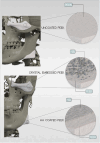Surface modification of PEEK implants for craniofacial reconstruction and aesthetic augmentation-fiction or reality?
- PMID: 38481611
- PMCID: PMC10936457
- DOI: 10.3389/fsurg.2024.1351749
Surface modification of PEEK implants for craniofacial reconstruction and aesthetic augmentation-fiction or reality?
Abstract
Facial implantology, a crucial facet of plastic and reconstructive surgery, focuses on optimizing implant materials for facial augmentation and reconstruction. This manuscript explores the use of Polyetheretherketone (PEEK) implants in craniofacial surgery, highlighting the challenges and advancements in this field. While PEEK offers mechanical resilience, durability, and compatibility with imaging modalities, its biologically inert nature hinders integration with the host tissue, which may lead to complications. In this systematic review, our aim was to assess the current state of knowledge regarding the clinical evaluation of Polyetheretherketone (PEEK) implants in facial implantology, with a focus on craniofacial augmentation and reconstruction in human studies. Additionally, we explore and discuss surface and structural modifications that may enhance bioreactivity and reduce complications in PEEK implants. A systematic review identified 32 articles detailing the use of PEEK Patient-Specific Implants (PSIs) in 194 patients for both reconstructive and aesthetic purposes. Complications, including infections and implant failures, were reported in 18% of cases, suggesting the need for improved implant materials. The discussion delves into the limitations of PEEK, prompting the exploration of surface and structural modifications to enhance its bioreactivity. Strategies, such as hydroxyapatite coating, titanium coating, and porous structures show promise in improving osseointegration and reducing complications. However, the literature review did not reveal reports of coated or modified PEEK in facial reconstructive or aesthetic surgery. In conclusion, although PEEK implants have been successfully used in craniofacial reconstruction, their biological inertness poses challenges. Surface modifications, particularly hydroxyapatite coatings, provide opportunities to promote osseointegration. Future research should focus on prospective long-term studies, especially in craniofacial surgery, to investigate the stability of uncoated PEEK implants and the potential benefits of surface modifications in clinical applications. Patient-specific PEEK implants hold promise for achieving durable craniofacial reconstruction and augmentation.
Keywords: PEEK; craniofacial; face; implant; polyether ether ketone (PEEK).
© 2024 Kauke-Navarro, Knoedler, Knoedler, Deniz and Safi.
Conflict of interest statement
The authors declare that the research was conducted in the absence of any commercial or financial relationships that could be construed as a potential conflict of interest.
Figures

References
-
- Yaremchuk MJ. Atlas of facial implants. New York: Elsevier Health Sciences; (2019).

